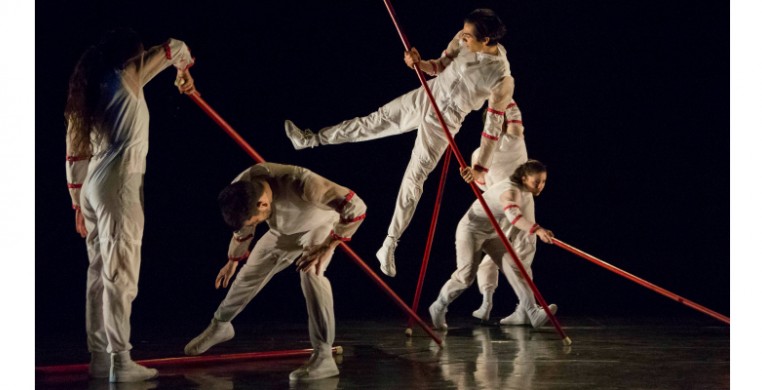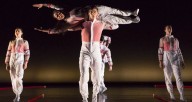Entering the Dance Center Thursday night, a tableau was already in motion on stage. A black and white color pallet tinted with metallic shades of gray is seen in topographic images cast across a series of five freestanding projection screens. Surrounding them, human sculptures slowly undulate as if doing t’ai chi, wearing headdresses and other adornments which, to me, looked like the ductwork of an HVAC system, architectural interests like soffits or moldings, and what could have been stylish IKEA chandeliers.
The scene is called “Fractals,” a prologue to Hedwig Dances’ world premiere “Futura,” on view through Saturday. A collaboration between the Bauhaus Dessau Foundation, the Illinois Institute of Technology (IIT) and Leviathan, a digital media firm based in Chicago, “Fractals” sets the mood for a main event inspired by modernist design principles which originated with German artists and architects, a school which plays a key role in the aesthetics of our city.
So it’s actually not too far of a stretch for Jan Bartoszek, a veteran choreographer who’s created dances in Chicago for more than 30 years, to use collaborations with the original Bauhaus school in Germany and the New Bauhaus, housed at IIT as the seed for “Futura.”
The birth of modernism was guided by a “back to basics” approach that, in Germany, was partly motivated by an economy in freefall. Visual artists and architects returned to the principles of line, shape and color – and re-considered superfluous, decorative elements which had no tangible purpose. As a point of comparison, take, for example, the building that used to house the Chicago Tribune, a neo-Gothic tower dripping with ornate opulence, and the one that it currently occupies: the stodgy, rectangular, gray Prudential Building. The former was built in 1925 at the height of the roaring ‘20s, the latter in 1955 at the height of mid-century modernism.
“Form follows function,” as the saying goes, but with dance, the form IS the function. Does that mean that everything a choreographer makes is necessary, or can dance exhibit some kind of unnecessarily ornate kind of opulence too?
Obviously the latter, but Bartoszek (assisted by artistic associate Maray Gutierrez Ramis) smartly employed this line of thought in creating “Futura,” a dance in three sections with two interludes which incorporate fascinating structural costume pieces by Sanja Manakoski.
When the dancers make a circle, or pick up a prop, as they do often in “Futura’s” first section using larger-than-life red polls, for example, they explore the infinite possibilities that exist within a certain set of limitations. What are all the options these polls present if they are suspended above the stage? What about when they are used to form a rigid boundary on the floor – shapes echoed by isolations with light mirroring the squares, rectangles, and circles (by Alexander Ridgers) formed by the dancers’ bodies, props, and costume pieces?
It’s a rigorous exercise in experimentation, which sometimes feels like it goes on too long – particularly in the work’s second section, a trio employing a bench that looks uncannily similar to another bench trio in the company’s semi-recent rep. Although, the seriousness of Bartoszek’s “back to basics” approach, exploiting any and all possibilities, lends “Futura” a playful and imaginative feeling, like children at play. As much as I felt myself steeped in the depths of abstract expressionist choreographic modernism (assuming that’s “a thing”), I also imagined myself back at the playground, making my own little world out of a box, a bench, or underneath the jungle gym.
On the other hand, subtle undertones of confinement make their way to the surface of this work, and given the history of the Bauhaus and its journey to Chicago – a group of “radical” artists shooed out of a country on the brink of World War II, one can’t help but draw parallels to an increasingly toxic version of nationalism at play, and not just here. Not for nothing, limitations and even oppression have forced some of our most treasured artistic products and movements, the Bauhaus among them.
“Futura” runs through Saturday at the Dance Center of Columbia College, 1306 S. Michigan Ave. Tickets are $30, with hot deals available at seechicagodance.com/event/futura


